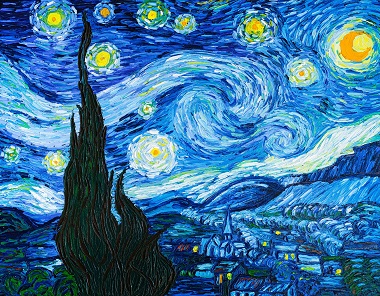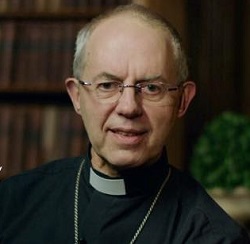
Markku Kostamo connects deeply with The Starry Night; Van Gogh’s birthday, March 30, now marks World Bipolar Day
Vincent Van Gogh painted his now famous The Starry Night in Saint Rémy de Provence’s psychiatric facility in June 1889 at the height of his prolific output, probably during an experience of mania.
Having visited Arles in Southern France, where Van Gogh did much of his painting, and having experienced my own visits to a psych ward, the piece has come to have a special place in my heart.
Van Gogh expresses the night sky’s haunting beauty as seen from his window at the psychiatric facility, and, in my mind, incorporates and communicates his intense interior state (both emotional and mental), most likely due to a bipolar condition.
The depths of depression are easy to identify in the darkness, as is Van Gogh’s self-identification in the dark silhouette of the cypress. [1]
What strikes me the most, however, is the juxtaposition of light and dark. There is more brightness in this nightscape than darkness and this light provides a sense of hope for me.
Although the swirling, ever brightening light in the night sky speaks of the journey into energizing hypomania and the bright high of mania, it also speaks to me personally of the brightness of hope in the midst of a ‘dark night,’ and the church reaching up to the sky symbolizes both faith and community to me.
My odyssey into mania culminated on my 47th birthday when friends intervened and took me to the emergency room where I was admitted to the psychiatric ward and diagnosed with mania and bipolar 1 disorder (formerly known as manic depression).
I pushed against the diagnosis and hospitalization in my ‘grandeur’ for a few days until I began listening to fellow patients, identifying with them. Seeing their misperceptions of reality mirrored back my own misconstrued narrative that mania had created.
While the immediate impacts of the experience of mania were life-altering and dramatic, the slower burn of living with undiagnosed bipolar disorder for over 20 years has proved to be the most damaging to relationships, particularly the most intimate ones in my life.
For years, I publicly acknowledged my struggle with seasonal depression, crediting the hypomanic highs and sustained energy to the ‘normal and ideal’ Markku. Little did I know how damaging this ‘successful and hypomanic Markku’ was in the hyper-productivity, overwork and lack of attunement to the people around me.
My recovery began with making amends and reconciling with people I had hurt – an ongoing journey that will take time, because trust building is a step-by-step process on the path to reciprocity.
Up to 50 percent of people living with bipolar disorders attempt suicide at least once in their lifetimes and over 15 percent die by suicide, most often during the darkness of deep depression.[2]
Like Van Gogh, suicidality has been a part of my own experience – an experience that has been complicated by the trauma and abandonment I endured when I was sent to boarding school as a six year old. My first memories of suicidal thoughts are as an eight year old, living in the aftermath of this trauma.
My eighth year was also the first time I acknowledged that I wanted to follow Jesus. My journey as a Jesus follower has taken twists and turns, like the Himalayan mountain paths I grew up walking as a missionary kid. What is remarkable is that I never gave up on Jesus, and more importantly, I profoundly felt that Jesus never gave up on me.
My experience of faith has been mystical – of being beloved. Through sermons, scripture reading, conversations with friends, contemplative prayer and experiences in creation, I hear the clear voice of Jesus say to me: “choose life.” Deuteronomy 30:19-20 has become a life motto:
Now choose life, so that you and your children may live and that you may love the Lord your God, listen to his voice, and hold fast to him. For the Lord is your life…
This motto is both literal and metaphorical, grounding the daily choices that I make to live well with bipolar disorder.
I have found that the people of God, as the church, can be a safe place for those experiencing mental health challenges.
I am so grateful for my faith community in particular, which I feel might well be ahead of many churches on this front. I have experienced acceptance, been treated with dignity, and have been listened to well. In particular, one-on-one conversations have been redemptive, as well as being invited to share my experience in the context of my faith community.
However, this acceptance is not always true amongst Christians in general; I have also experienced significant stigma. I feel called to push into this stigma to help normalize conversations around faith and mental health, and I’d like to be an advocate for these conversations in the context of faith so that we can talk about mental health as easily as we talk about diabetes or having surgery.
A test in our congregations might be if we can add a mental health issue to the prayer chain just like we add our friend’s chronic illness.
Still learning from many who have gone ahead of me, I now know that it is possible to live well with bipolar disorder and to even flourish. Having a bipolar condition is teaching me that I need a new style of work that includes healthy boundaries, so I have committed to taking my medication regularly and making lifestyle changes, including regular sleep routines, decreasing stress, weekly therapy, monthly spiritual direction, helpful reading, pursuing relationships, daily contemplative prayer and being active outside.
I can now choose how to respond rather than just react. I am understanding the necessity of balance and realizing I don’t need to have control of everything. I experience hope in and through my community of family, friends, faith and colleagues. I am also grateful for meaningful work that gives me a sense of purpose. Most of all, I am thankful for this net that caught me – I am beloved and I am enough.
It is little wonder that I connect so deeply with The Starry Night; Van Gogh, whose birthday on March 30 marks World Bipolar Day, is thought to have had a bipolar illness.
The day was conceived to raise awareness of the condition and to eliminate associated social stigma, as well as to “inspire a global shift in thinking that will eliminate social stigma and promote acceptance” of bipolar disorder.[3] It is also a day where people struggling with bipolar disorder are encouraged to ‘come out’ and stare stigma down. Together we can! #Bipolarbrave!
[1] “Analysis of Vincent Van Gogh’s Starry Night,” Life of Van Gogh, https://lifeofvangogh.com/paintings/analysis-of-vincent-van-goghs-starry-night/.
[2] Kay Redfield Jamison, “Suicide and Bipolar Disorder,” J Clin Psychiatry 61 (2000):47-51, https://www.psychiatrist.com/wp-content/uploads/2021/02/17998_suicide-bipolar-disorder.pdf Michele Bloomquist, “Bipolar Disorder and the Risk of Suicide,” Everyday Health (October 15, 2008), https://www.everydayhealth.com/bipolar-disorder/bipolar-and-suicide-risk.aspx.
[3] World Bipolar Day (WBD) is an initiative of the International Bipolar Foundation (IBPF) in collaboration with the Asian Network of Bipolar Disorder (ANBD) and the International Society for Bipolar Disorders (ISBD). See https://ibpf.org/learn/programs/world-bipolar-day/ for more information.

Markku Kostamo
Markku Kostamo, MSc, currently serves as Director of Development with Sanctuary Mental Health Ministries. Markku has served as an executive in the non-profit sector for over 20 years and is passionate about seeing organizations grow and develop in executing their mission and impact. To enable this, Markku takes an entrepreneurial and relational approach to revenue generation and partnerships.
This comment is re-posted by permission from the Sanctuary site.
Sanctuary, though based in Vancouver, is playing an increasingly international role. Archbishop of Canterbury Justin Welby posted this appreciative message on his Facebook page February 28:
This is a difficult time for so many of us, a time of uncertainty and unpredictability. We are facing much loss and grief. How do we understand suffering as Christians? Where do we find hope when things are really hard?
Sanctuary Mental Health Ministries have prepared free resources to equip Christians to think about these tough questions, and explore mental health from psychological, social and theological perspectives.

Justin Welby endorses Sanctuary.
The message of Jesus Christ is that he does not watch from afar when we are suffering. He climbs into the messiness and brokenness of the world to be with us, and He calls us to be there for one another as well.
God does not ask us to be perfect; he calls for those who are struggling to come as they are. He listens to our troubles and offers love and acceptance .
If you are feeling overwhelmed or exhausted, have a look at the resources on offer from Sanctuary Mental Health Ministries.
Perhaps you could do The Sanctuary Course, an eight week study guide, with a small group, or subscribe to their podcast on faith and mental health challenges. If you are struggling with mental health issues, reach out to a loved one or a medical professional. You are not alone.

Great article, Sanctuary website looks great, the church’s mission is healing, it’s what Jesus spent a lot of time doing . . . we tend to forget that and think he just gave sermons. Jesus would have loved “Starry Night.”
So inspiring to hear beloved Markku’s story. Hopefully, his voice and others will be a clarion call for us to be less stigmatizing and more understanding of mental health. As someone who has dealt periodically over my life with depression and anxiety, I appreciate Markku’s vulnerability. His story can open the gates to healing for many if we want it to. Listen up, everyone.